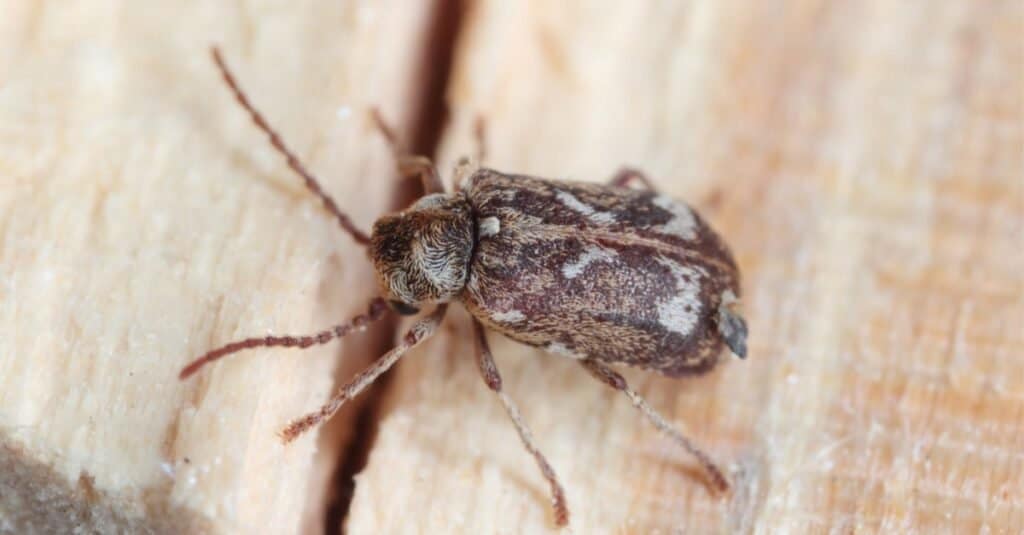Deathwatch Beetle
Xestobium rufovillosum
The adult deathwatch beetle taps on the wood to find a mate.
Advertisement
Deathwatch Beetle Scientific Classification
- Kingdom
- Animalia
- Phylum
- Arthropoda
- Class
- Insecta
- Order
- Coleoptera
- Family
- Ptinidae
- Genus
- Xestobium
- Scientific Name
- Xestobium rufovillosum
Read our Complete Guide to Classification of Animals.
Deathwatch Beetle Conservation Status
Deathwatch Beetle Facts
- Name Of Young
- Larvae
- Group Behavior
- Solitary
- Fun Fact
- The adult deathwatch beetle taps on the wood to find a mate.
- Estimated Population Size
- Unknown
- Biggest Threat
- None
- Most Distinctive Feature
- The mottled brown shell
- Other Name(s)
- Woodworm
- Gestation Period
- A month
- Litter Size
- 40-80 eggs
- Habitat
- Anywhere with wood
- Predators
- Mammals, birds, spiders, and other insects
- Diet
- Herbivore
- Favorite Food
- Wood
- Type
- Insect
- Common Name
- Deathwatch Beetle
- Number Of Species
- 1
- Location
- Europe and North America
View all of the Deathwatch Beetle images!
The deathwatch beetle is a wood-boring insect that can infest wooden buildings and become an annoying pest.
It can feed on all kinds of different wood, but old oak appears to be one of its favorite potential hosts. The deathwatch beetles were once considered to be signs of an ill omen and a portent of death because their rhythmic tapping sound (which is actually a part of their mating behavior) mimics the ticking countdown of a watch. This article will cover some interesting facts about the identification, habitat, diet, and treatment of the deathwatch beetle.
3 Incredible Deathwatch Beetle Facts!
- The deathwatch beetle passes through four distinct stages in its life cycle: eggs, larva, pupa, and adult. The larva has a slow development period that may last up to 10 years at a time. Once it has grown, the beetle will enter a pupa chamber close to the surface of the wood. This process takes about a month, but if it hasn’t transformed into an adult by the time winter arrives, then it may wait for the following spring by suspending its development. The adult deathwatch only has about a month or two to find a mate and reproduce before it perishes.
- One of the most unique and interesting facts about this species is its tapping ability. The male deathwatch is normally the one who initiates this ritual. He creates the sound by hitting his head against the wood. A nearby female will usually respond within two seconds. As they continue to communicate with each other via tapping, the male will slowly make his way toward the female based on the direction of the sound.
- The adult female uses her finely tuned sense of smell to find a suitable wood host to lay her eggs in. The fungi-softened wood often produces a pungent smell that attracts them. She will lay batches of 40 to 80 eggs right in the crevices or holes of the wood.
Deathwatch Beetle Species, Types, and Scientific Name
The scientific name of the deathwatch beetle is Xestobium rufovillosum. It is closely related to the common furniture beetle and other wood-boring insects in the family of Ptinidae.
Appearance: How to Identify the Deathwatch Beetle
The deathwatch is a small beetle, measuring a mere fraction of an inch in size, with a brown-colored shell and tiny hairs covering the entire body that should assist with identification. The head is almost completely covered by the thorax. The wings are also hidden beneath the shell, but this species is a relatively weak flyer and rarely wanders very far from its woody habitat. The larvae, by contrast, look nothing like the adults. This white-colored grub has six legs, black jaws, and a pair of eyespots on the sides of the head. They grow up to 0.4 inches in size, just as large as the adults themselves. The pupa, encased in its cocoon-like shell, is milky white in color and then gradually darkens as it matures into an adult.

©Tomasz Klejdysz/Shutterstock.com
Habitat: Where to Find the Deathwatch Beetle
The deathwatch beetle has a wide distribution all across North America and Europe. The larvae take up residence inside of old decaying trees or buildings softened up by fungi. Oak is among their favorite hosts. Their tunneling can cause significant damage to wood because they will use up the habitat until it’s no longer suitable as a source of food.
Diet: What Does the Deathwatch Beetle Eat?
The deathwatch is an herbivorous insect. It consumes nothing but wood.
What eats the deathwatch beetle?
This species is preyed upon by numerous types of animals, including birds and mammals. Perhaps the most common predator of the deathwatch (as well as the common furniture beetle) is the steely blue beetle. This insect will lay its eggs near the exit hole of the wood. Then the steely blue larvae will wander through the galleries and feed on the smaller larvae of the deathwatch and furniture beetles. When threatened, the adult will pull in its legs and attempt to play dead. The deep woody habitat in which it hides also offers a strong degree of protection against most predators except for the steely blue beetle.
What does the deathwatch beetle eat?
The diet of the deathwatch beetle consists of the softwood on which they’re laid. The larvae have digestive proteins in their stomach that can digest the tough cellulose of the wood, at least after it’s first softened up by the fungi. The technical term for an herbivorous animal that consumes wood is xylophagy.
Prevention: How to Get Rid of the Deathwatch Beetle
The wood-boring behavior of the deathwatch beetle can do immense damage to wooden structures. The good news is that this species prefers old hardwood timber over modern softwood timber, which means they tend to target historic buildings, but no infestation should be neglected for long. If you’re dealing with a smaller outbreak in your furniture, then it may be possible to end the infestation with the use of a simple woodworm pesticide. If they’ve gotten into the deeper structures of the home, however, then it will be much more difficult to deal with them.
Most commercial treatment options either won’t penetrate far enough into the wood or they’re far too difficult to implement on your own. You may need to contact a trained professional to deal with the problem. A professional will usually employ a pest control method that requires significant expertise. Ultrasound techniques can help locate all the tiny holes in the wood with a great degree of accuracy. They may try to employ a modern method of pest control in which they drill very small holes into the wood and introduce some kind of pesticide via a needle directly where the insects are located. It can be very difficult to prevent the deathwatch from infesting wood, but if you own an old hardwood home or building, then you should make sure the wood is always in good shape.
View all 110 animals that start with DDeathwatch Beetle FAQs (Frequently Asked Questions)
What is a deathwatch beetle?
The deathwatch is a type of wood-boring beetle that inhabits and infests soft wooden structures, particularly oak. Their burrowing behavior makes identification fairly easy, even apart from their appearance. The economic damage they cause can be significant.
Are deathwatch beetles dangerous to humans?
The deathwatch does not pose any direct danger to people, but it can cause immense damage to wooden structures, old oak homes in particular.
How many legs does the deathwatch beetle have?
Like all insects, the deathwatch has six legs.
How do you get rid of the deathwatch beetle?
The deathwatch is not an easy insect to get rid of. If the damage is superficial, then a deathwatch infestation can be handled with chemical treatment alone. But if the damage is deep and structural, then pest control becomes much more challenging, and you may need to contact a professional.
What does a deathwatch beetle represent?
The deathwatch beetles were traditionally seen as signs of bad luck and tragedy. Their loud tapping at night, while completely harmless, seemed to be a bad omen. An old folk tradition claimed that the deathwatch was a portent of death. But in reality, they’re only a bad omen for the wood of your home.
Where do deathwatch beetles live?
These beetles spend most of their lives burrowed in the surface of the wood. They can be found in Europe and North America. It is particularly common in the southern forests of the United Kingdom.
How do I know if I have deathwatch beetles?
The tapping sounds you may hear at night are very obvious signs of a deathwatch infestation. You may also notice small tunnels burrowed into the wood of your home. It prefers to only infest hardwood surfaces.
Is a deathwatch beetle the same as a woodworm?
Woodworm can be defined as any wood-eating larva of a beetle species; it’s not really a taxonomical term but more of a descriptive one. This means the larva of the deathwatch beetle is considered to be a type of woodworm. The adult is not really described as a woodworm though.
Thank you for reading! Have some feedback for us? Contact the AZ Animals editorial team.
Sources
- Britannica, Available here: https://www.britannica.com/animal/deathwatch-beetle
- The Wildlife Trusts, Available here: https://www.wildlifetrusts.org/wildlife-explorer/invertebrates/beetles/deathwatch-beetle
- BPCA, Available here: https://bpca.org.uk/a-z-of-pest-advice/death-watch-beetles-control-bpca-a-z-of-pests/189160

















